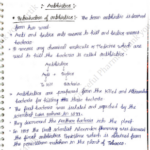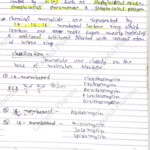www.DuloMix.com
GUJARAT TECHNOLOGICAL UNIVERSITY
M.Pharm
Pharmaceutics (20)
SEMESTER: II
Subject Name: Molecular Pharmaceutics(Nano Tech and Targeted DDS)
Subject Code: MPH201T
Scope: This course is designed to impart knowledge on the area of advances in novel drug delivery
systems
Objectives: Upon completion of the course student shall be able to understand
1. The various approaches for development of novel drug delivery systems.
2. The criteria for selection of drugs and polymers for the development of NTDS
3. The formulation and evaluation of novel drug delivery system
Sr. Topic Hr
1. Targeted Drug Delivery Systems: Concepts, Events and biological process 12
involved in drug targeting. Tumor targeting and Brain specific delivery.
2. Targeting Methods: introduction preparation and evaluation. Nano Particles & 12
Liposomes: Types, preparation and evaluation.
3. Micro Capsules / Micro Spheres: Types, preparation and evaluation, Monoclonal 12
Antibodies; preparation and application, Preparation and application of Niosomes,
Aquasomes, Phyotosomes, Electrosomes
4. Pulmonary Drug Delivery Systems : Aerosols, propellents, ContainersTypes, 12
preparation andevaluation, Intra Nasal Route
Deliverysystems;Types,preparationandevaluation
5. Nucleic acid based therapeutic delivery system : Gene therapy, introduction (ex-vivo 12
& in-vivo gene therapy). Potential target diseases for genetherapy (inherited disorder
andcancer). Gene expression systems (viral andnonviral genetransfer). Liposomal gene
deliverysystems. Biodistribution and Pharmacokinetics. knowledge of therapeutic
antisensemoleculesandaptamersasdrugs offuture
REFERENCES:
1. Y W. Chien, Novel Drug Delivery Systems, 2nd edition, revised and expanded,Marcel
Dekker,Inc.,NewYork,1992
2. S.P.Vyas and R.K.Khar, Controlled Drug Delivery – concepts and
advances,VallabhPrakashan,New Delhi,Firstedition 2002
3. N.K. Jain, Controlled and Novel Drug Delivery, CBS Publishers &
Distributors,NewDelhi,Firstedition 1997 (reprint in2001).
www.DuloMix.com
GUJARAT TECHNOLOGICAL UNIVERSITY
M.Pharm
Pharmaceutics (20)
SEMESTER: II
Subject Name: Advanced Biopharmaceutics & Pharmacokinetics
Subject Code: MPH202T
Scope: This course is designed to impart knowledge and skills necessary for dose calculations, dose
adjustments and to apply biopharmaceutics theories in practical problem solving. Basic theoretical
discussions of the principles of biopharmaceutics and pharmacokinetics are provided to help the
students’ to clarify the concepts.
Objectives: Upon completion of the course student shall be able to understand
1. The basic concepts in biopharmaceutics and pharmacokinetics.
2. The use raw data and derive the pharmacokinetic models and parameters the best describe the
process of drug absorption, distribution, metabolism and elimination.
3. The critical evaluation of biopharmaceutic studies involving drug product equivalency.
4. The design and evaluation of dosage regimens of the drugs using pharmacokinetic and
biopharmaceutic parameters.
5. The potential clinical pharmacokinetic problems and application of basics of pharmacokinetic
Sr. Topic Hr
1. Drug Absorption from the Gastrointestinal Tract: Gastrointestinal tract, Mechanism of 12
drug absorption, Factors affecting drug absorption, pH–partition theory of drug
absorption. Formulation and physicochemical factors: Dissolution rate, Dissolution
process, Noyes–Whitney equation and drug dissolution, Factors affecting the
dissolution rate. Gastrointestinal absorption: role of the dosage form: Solution (elixir,
syrup and solution) as a dosage form ,Suspension as a dosage form, Capsule as a
dosage form, Tablet as a dosage form ,Dissolution methods ,Formulation and
processing factors, Correlation of in vivo data with in vitro dissolution data. Transport
model: Permeability-Solubility-Charge State and the pH Partition Hypothesis,
Properties of the Gastrointestinal Tract (GIT), pH Microclimate Intracellular pH
Environment, Tight-Junction Complex.
2. Biopharmaceutic considerations in drug product design and In Vitro Drug Product 12
Performance: Introduction, biopharmaceutic factors affecting drug bioavailability,
rate-limiting steps in drug absorption, physicochemical nature of the drug formulation
factors affecting drug product performance, in vitro: dissolution and drug release
testing, compendial methods of dissolution, alternative methods of dissolution testing,
meeting dissolution requirements, problems of variable control in dissolution testing
performance of drug products. In vitro–in vivo correlation, dissolution profile
comparisons, drug product stability, considerations in the design of a drug product.
3. Pharmacokinetics: Basic considerations, pharmacokinetic models, compartment 12
modeling: one compartment model- IV bolus, IV infusion, extra-vascular. Multi
compartment model: two compartment – model in brief, non-linear pharmacokinetics:
cause of non-linearity, Michaelis – Menten equation, estimation of kmax and vmax.
Drug interactions: introduction, the effect of protein binding interactions, the effect of
tissue-binding interactions, cytochrome p450-based drug interactions, drug interactions
linked to transporters
www.DuloMix.com
4. Drug Product Performance, In Vivo: Bioavailability and Bioequivalence: drug product 12
performance, purpose of bioavailability studies, relative andabsolute availability.
methods for assessing bioavailability, bioequivalence studies, design and evaluation of
bioequivalence studies, study designs, crossover study designs, evaluation of the data,
bioequivalence example, study submission and drug review process. biopharmaceutics
classification system, methods. Permeability: In-vitro, in-situ and In-vivo methods.
generic biologics (biosimilar drug products),clinical significance of bioequivalence
studies, special concerns in bioavailability and bioequivalence studies, generic
substitution
5. Application of Pharmacokinetics: Modified-Release Drug Products, Targeted Drug 12
Delivery Systems and Biotechnological Products. Introduction to Pharmacokinetics
and pharmacodynamic, drug interactions. Pharmacokinetics and pharmacodynamics of
biotechnology drugs. Introduction, Proteins andpeptides, Monoclonal antibodies,
Oligonucleotides, Vaccines (immunotherapy),Genetherapies
REFERENCES:
1. Biopharmaceutics and Clinical Pharmacokinetics by Milo Gibaldi, 4th
edition,Philadelphia,LeaandFebiger,1991
2. Biopharmaceutics and Pharmacokinetics, A. Treatise, D .M. Brahmankar and Sunil B.
Jaiswal.,Vallab Prakashan, Pitampura, Delhi
3. Applied Biopharmaceutics and Pharmacokinetics by Shargel. Land
YuABC,2ndedition,ConnecticutAppletonCenturyCrofts,1985
4. Textbook of Biopharmaceutics andPharmacokinetics, Dr. Shobha Rani R. Hiremath,PrismBook
5. Pharmacokinetics by Milo Gibaldi and D. Perrier, 2nd edition, Marcel DekkerInc.,New York,1982
6. Current Concepts in Pharmaceutical Sciences: Biopharmaceutics,
Swarbrick.J,LeaandFebiger,Philadelphia,1970
7. Clinical Pharmacokinetics, Concepts and Applications 3rd edition by MalcolmRowland and
Thom~N. Tozer, Lea and Febiger, Philadelphia, 1995
8. Dissolution, Bioavailability and Bioequivalence, Abdou. H.M, Mack
PublishingCompany,Pennsylvania1989
9. Biopharmaceutics and Clinical Pharmacokinetics, An Introduction, 4th edition,revised andexpande
byRobert. E. Notari, Marcel Dekker Inc,New YorkandBasel,1987
10. BiopharmaceuticsandRelevantPharmacokineticsbyJohn.G Wagnerand M.Pemarowski, 1st edition,
Drug Intelligence Publications, Hamilton, Illinois, 1971
11. Encyclopedia of Pharmaceutical Technology, Vol 13, James Swarbrick,
James.G.Boylan,MarcelDekkerInc,New York,1996
12. Basic Pharmacokinetics,1 st edition,Sunil S JambhekarandPhilip J Breen,pharmaceuticalpress,RPS
Publishing,2009
13. Absorption and Drug Development- Solubility, Permeability, and Charge
State,AlexAvdeef,JohnWiley&Sons,Inc,2003
www.DuloMix.com
GUJARAT TECHNOLOGICAL UNIVERSITY
M.Pharm
Pharmaceutics (20)
SEMESTER: II
Subject Name: COMPUTER AIDED DRUG DEVELOPMENT
Subject Code: MPH203T
Scope: This course is designed to impart knowledge andskills necessary for computer Applications in
pharmaceutical research and development who want to understand the application of computers across the
entire drug research and development process. Basic theoretical discussions of the principles of more
integrated and coherent use of computerized information (informatics) in the drug development process are
provided to help the students to clarify the concepts.
Objectives: Upon completion of the course student shall be able to understand
1. History of Computers in Pharmaceutical Research and Development
2. Computational Modeling of Drug Disposition
3. Computers in Preclinical Development
4. Optimization Techniques in Pharmaceutical Formulation
5. Computers in Market Analysis
6. Computers in Clinical Development
7. Artificial Intelligence(AI) and Robotics
8. Computational fluiddynamics (CFD)
Sr. Topic Hr
1. a. Computers in Pharmaceutical Research and Development: A General Overview: 12
History of Computers in Pharmaceutical Research and Development. Statistical
modeling in Pharmaceutical research and development: Descriptive versus Mechanistic
Modeling, Statistical Parameters, Estimation, Confidence Regions, Nonlinearity at the
Optimum, Sensitivity Analysis, Optimal Design, Population Modeling b. Quality-by-
Design In Pharmaceutical Development: Introduction, ICH Q8guideline, Regulatory
and industry views on QbD, Scientifically based QbD-examples of application
2. Computational Modeling Of Drug Disposition: Introduction ,Modeling Techniques: 12
Drug Absorption, Solubility, Intestinal Permeation, Drug Distribution ,Drug Excretion,
Active Transport; P-gp, BCRP, Nucleoside Transporters, hPEPT1, ASBT, OCT,
OATP,BBB-CholineTransporter
3. Computer-aided formulation development:: Concept of optimization, Optimization 12
parameters, Factorial design, Optimization technology & Screening design. Computers
in Pharmaceutical Formulation: Development of pharmaceutical emulsions, micro
emulsion drug carriers Legal Protection of Innovative Uses of Computers in R&D, The
Ethics of Computing in Pharmaceutical Research, Computers in Market analysis
4. a. Computer-aided biopharmaceutical characterization: Gastrointestinal absorption 12
simulation. Introduction, Theoretical background, Model construction, Parameter
sensitivity analysis, Virtual trial, Fed vs. fasted state, In vitro dissolution and in vitroin
vivo correlation, Biowaiver considerations b. Computer Simulations in
Pharmacokinetics and Pharmacodynamics: Introduction, Computer Simulation: Whole
Organism, Isolated Tissues, Organs, Cell, Proteins and Genes. c. Computers in Clinical
Development: Clinical Data Collection and Management, Regulation of Computer
Systems
www.DuloMix.com
5. Artificial Intelligence (AI), Robotics and Computational fluid dynamics: General 12
overview, Pharmaceutical Automation, Pharmaceutical applications, Advantages and
Disadvantages. Current Challenges and Future Directions
REFERENCES:
1. Computer Applications in Pharmaceutical Research and Development, Sean
Ekins,2006,JohnWiley&Sons.
2. Computer-Aided Applications in Pharmaceutical Technology, 1st Edition,
JelenaDjuris,Woodhead Publishing 3. Encyclopedia of Pharmaceutical Technology, Vol 1
3. James Swarbrick, James.G.Boylan,MarcelDekkerInc,New York,1996.
www.DuloMix.com
GUJARAT TECHNOLOGICAL UNIVERSITY
M.Pharm
Pharmaceutics (20)
SEMESTER: II
Subject Name: COSMETICS AND COSMECEUTICALS
Subject Code: MPH204T
Scope: This course is designed to impart knowledge and skills necessary for the fundamental need for
cosmetic and cosmeceutical products
Objectives: Upon completion of the course student shall be able to understand
1. Key ingredients used in cosmetics and cosmeceuticals.
2. Key building blocks for various formulations.
3. Current technologies in the market
4. Various key ingredients and basic science to develop cosmetics and cosmeceuticals
5. Scientific knowledge to develop cosmetics and cosmeceuticals with desired Safety, stability, and
efficacy
Sr. Topic Hr
1. Cosmetics – Regulatory : Definition of cosmetic products as per Indian regulation. 12
Indian regulatory requirements for labeling of cosmetics Regulatory provisions relating
to import of cosmetics., Misbranded and spurious cosmetics. Regulatory provisions
relating to manufacture of cosmetics – Conditions for obtaining license, prohibition
of manufacture and sale of certain cosmetics, loan license, offences and penalties
2. Cosmetics – Biological aspects : Structure of skin relating to problems like dry skin, 12
acne, pigmentation, prickly heat, wrinkles and body odor. Structure of hair and hair
growth cycle. Common problems associated with oral cavity. Cleansing and care needs
for face, eye lids, lips, hands, feet, nail, scalp, neck, body and under-arm
3. Formulation Building blocks: Building blocks for different product formulations of 12
cosmetics/cosmeceuticals. Surfactants – Classification and application. Emollients,
rheological additives: classification and application. Antimicrobial used as
preservatives, their merits and demerits. Factors affecting microbial preservative
efficacy. Building blocks for formulation of a moisturizing cream, vanishing cream,
cold cream, shampoo and toothpaste. Soaps and syndetbars. Perfumes; Classification
of perfumes. Perfume ingredients listed asallergens in EU regulation
Controversial ingredients: Parabens, formaldehyde liberators, dioxane
4. Design of cosmeceutical products: Sun protection, sunscreens classification and 12
regulatory aspects. Addressing dry skin, acne, sun-protection, pigmentation, prickly
heat, wrinkles, bodyodor., dandruff, dental cavities, bleeding gums, mouth odor and
sensitive teeth through cosmeceutical formulations
5. Herbal Cosmetics : Herbal ingredients used in Hair care, skin care andoral care. Review 12
of guidelines for herbal cosmetics by private bodies like cosmos with respect to
preservatives, emollients, foaming agents, emulsifiers and rheology modifiers.
Challenges in formulating herbal cosmetics
REFERENCES:
1. Harry’sCosmeticology.8th edition.
2. Poucher’sperfumecosmeticsandSoaps,10th edition.
3. Cosmetics – Formulation, Manufacture and quality control, PP.Sharma,4th edition
www.DuloMix.com
4. Handbook of cosmetic science and Technology A.O.Barel, M.Paye and H.I.Maibach.3rdedition
5. Cosmetic and Toiletries recent suppliers catalogue.
6. CTFA directory
www.DuloMix.com
GUJARAT TECHNOLOGICAL UNIVERSITY
M.Pharm
Pharmaceutics (20)
SEMESTER: II
Subject Name: PHARMACEUTICS PRACTICALS – II
Subject Code: MPH205P
1. To study the effect of temperature change , non solvent addition, incompatible polymer additionin
microcapsules preparation
2. Preparation and evaluation of Alginatebeads
3. Formulation and evaluation of gelatin /albuminmicrospheres
4. Formulation and evaluation of liposomes/niosomes
5. Formulation and evaluation of spherules
6. Improvement of dissolution characteristics of slightly soluble drug by Solid dispersion technique.
7. Comparison of dissolution of two different marketed products /brands
8. Protein binding studies of a highly protein bound drug & poorly protein bound drug
9. Bioavailability studies of Paracetamolin animals.
10. Pharmacokinetic and IVIVC data analysis by Winnoline R software
11. In vitro cells tudies for permeability and metabolism
12. DoE Using Design Expert® Software
13. Formulation data analysis Using Design Expert® Software
14. Quality-by-DesigninPharmaceuticalDevelopment
15. Computer Simulation sin Pharmacokinetics and Pharmacodynamics
16. Computational Modeling Of Drug Disposition
17. To develop Clinical Data Collection manual
18. To carry out Sensitivity Analysis, and Population Modeling.
19. Development and evaluation of Creams
20. Development and evaluation of Shampoo and Toothpaste base
21. To incorporate herbal and chemical actives to develop products
22. To address Dry skin, acne, blemish, Wrinkles, bleeding gums and dandruff










